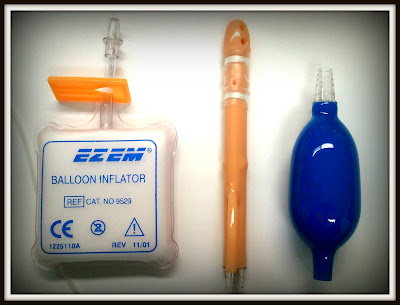Tomography can be defined as the radiographic technique that employs motion to show anatomical structures lying in a plane of tissue while blurring or eliminating the detail in images of structures above and below the plane of interest.
Tomographic principle: you must have 2 of the 3 elements in synchronous movement during your exposure (for kidney tomography, this would be the tube and image receptor, while the patient lies still). A panorex machine would be another example of the same principles.

The above diagram illustrates the necessary components:
You must have an adjustable fulcrum (pivot point) that allows you to change the area of beam focus. This is the "cm" adjustment you make between tomo slices, and should be adjusted to the hight of the anatomy of interest. I will discuss this momentarily.
Focal Plane: region in which the image exhibits satisfactory recorded detail, and is controlled by the level of the fulcrum. This region will show the least amount of radiographic motion, thus will appear clearly defined on the radiograph. Anything above or below this plane will be blurred due to tube/receptor motion.

Section thickness: Consider the above diagram in which the the width of the focal plane (represented by the vertical distance between points A and B )is controlled by the exposure (or tomographic) angle as seen in the above diagram. The exposure angle is inversely proportional to section thickness. As exposure angle increases, section thickness decreases. So in essence, if you want the whole kidney to appear more focused, you would have a narrow exposure angle (10 degrees for example), giving you a "thicker" cut. As in most IVP's, you want "thin" cuts (30-40 degrees for example), requiring three to four different slices at different incriments to visualize the whole kidney. The thinner your slice, the more detail for small parts will be visible. If there is a 2mm renal stone, you may not get a clear visualization of its structure or an accurate assessment of its location with a thick slice.
Remember that there are two arcs when talking about tomograms. When you "adjust the arc," you are adjusting the amount of exposure travel, not tube travel. The tomographic arc is how far the tube travels from start to finish, but remember that the exposure is not being made for the entire duration of travel. The tube must accelerate to a constant speed before the exposure begins, then the "exposure arc" starts.

Exposure factors:
Time – always set time first. Exposure time must = time required for exposure amplitude (or the minimum amount of time required for the tube to travel). Less time results in not enough blur. More time results in unwanted increase in density at the final tube position, increasing recorded detail and decreasing blur.
mA – usually a low mA setting required (10-50 mA). Wide angle tomograms usually require 30-50% more mAs than static films.
kV – Fine density adjustments must be accomplished by variations of kV because of the limitations of fixed-time settings. You must apply the 15% rule for density. Keep in mind that you should read the recommended kV range on the insert that comes with the contrast your facilty purchases. For nonionic iodinated contrast, that range is typically 65-70 kV.
Specialized Techniques:
Zonography – narrow angle tomography, usually less than 10 degree exposure amplitude. Used when a thick section is required (as in determining the location of a lung or renal lesion, cyst, or large stone). This method provides great contrast, but poor recorded detail due to the thickness of a section.
Wide-angle tomography – once a lesion has been localized, this is used to provide more specific detail. This is typically used for IVP’s with a series of thinner sections with varied focal points, as previously discussed. CT has taken over much usefulness for exams such as the bones of the inner ear. This method will be the most familiar to technologists today because it is used in routine IVP studies.
Panoramic tomography – used for curved surfaces of the head. Also known as orthopantomography, a lead mask is used over the xray tube which collimates the beam to a thin slit. The tube rotates around the patient’s head, and the film correspondingly rotates, staying perpendicular to the central ray. If you've never seen a panorex machine, you've probably never been to the dentist... time to go! The are simple to use and provide beautiful images, but are rarely seen in a hospital setting.
So how do I know how to set my focal point (adjust cm range)?
I'm sure you learned one rule of thumb in school or your clinical facility. There are many variances, so I'll choose the one I learned in school: Measure with calipers through the central ray of your kidney tomo (we'll say our pseudo-patient measures 21cm). Divide that number by 3 (21/3 = 7) and add 1 (7+1 = 8cm). That is my starting point for my scout.
Depending on what I see from my scout tomo, I can adjust to include slices focused throughout the kidneys. How do I do that? And why do I divide by three and add one cm? First, review the renal anatomy on this CT image:

If you notice the location of the kidneys, they lie approximately in the postierior 1/3 of the abdomen (remember the term "retroperitoneal"?). When you set your fulcrum, you are seting the distance from the image receptor to the part of the anatomy you want focused on your film. In this scenario, the kidneys lie approximately 8cm from the IR. Your scout image should be focused at the center of the kidney (with the renal pelvis showing clarity).
How do I adjust my settings to ensure that my tomo slices with contrast will all focus within the kidney?
This really has a lot to do with film critique and good knowledge of anatomy. In this first image (I apologize for the crudeness of it), the lamina of the L-spine are seen very clearly in focus. We know that the lamina are posterior to the vertebral bodies, and even more importantly, lie in the same plane as the posterior aspect of the kidneys (see CT image for reference). If you have spinous processes focused in your image, you are way too posterior... you would need to increase your fulcrum point. If you originally set 7cm, try 9 or 10cm.

The second image displays a more acceptable focal point. The renal pelvis is in focus, and notice the part of the spine that is focused, the vertebral body. You can see clear, concise detail and if this were taken at 7cm, I would probably do additional cuts at 6cm and 8cm (one cm above and below this slice) because I know the renal pelvis lies in the approximate center of the kidney from anterior to posterior.

I hope this has been a practical post, and if there are any unclear concepts presented that need further elaboration, feel free to leave comments.



















